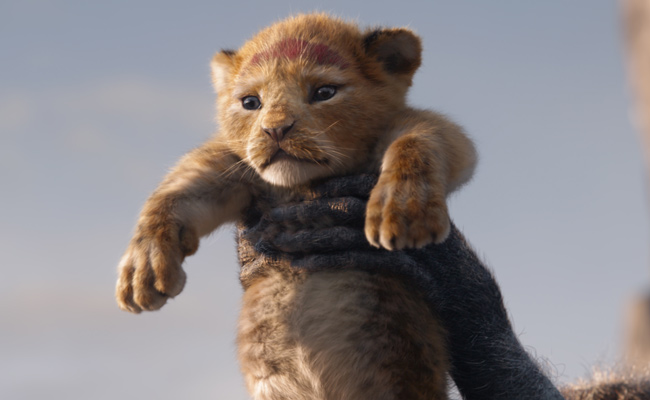
One of the many revenue streams these days for Disney, who account for about 35% of the total box office this year, is making live-action remakes of their cartoon classics, like Dumbo and Aladdin (both released earlier this year). In the business, they call this “utilizing existing IP,” a strategy Disney’s President of Production Sean Bailey likened to “A better Art of War (…). You take the high ground rather than fight up a hill.”
The twist with The Lion King is that, since lions can’t act, this Lion King remake isn’t “live action” so much as a different form of animation made to look like live-action. And boy does it look real! Disney has used state-of-the-art animation technology to create CGI lions, hyenas, warthogs, and meerkats that look startlingly real and placed them in photographed backdrops. Other than that, much of The Lion King is a shot-for-shot remake of the original. To the point that it’s hard to imagine what “director” Jon Favreau even did, other than scout locations, shoot backdrops, and guide the actors as they recorded their lines (though to be fair, the location scouting part does sound pretty hard, having to find real landscapes that perfectly match a cartoon from the ’90s).
The central flaws of this strategy become apparent in the first five minutes of the movie (which treats us to the entire BAAAAAAAAHHHHNSOMEWHENYAAAAAA opening sunrise sequence). It seems that in making the lions look just like real lions, they’ve removed almost all the facial expressiveness of the original — the thing that makes them characters. The lions’ mouths move and their eyes squint a little sometimes, but for the most part this $260 million film mostly looks like an old episode of Mr. Ed where the animals’ lips move and actors dub the words coming out.
Was it worth it? In some ways it’s a reverse of the usual automation-replacing-jobs story. Instead of one horse with peanut butter in his mouth, Lion King has 1500 Korean animators (I’m only guessing here). The one job all that computing power did away with was the guy who puts the peanut butter in the animals’ mouths, and in the case of all these lions he was probably better off.
Another very weird thing about this Lion King, which is very weird from top to bottom, is that the “realism” of the animation has clear limits. To wit: the lions don’t have genitalia. That’s not something one tends to notice in a cartoon, but when lions that are otherwise photoreal in every other way squat down and roll over and we only see a smooth spot where their genitals would normally be, it’s hard not to fixate on it. I zoned out at least 10 minutes of screen time as I sat there imagining the big board meeting that must’ve happened where men in suits sat around a conference table weighing the pros and cons of visible lion genitals. “Lion penises?! With children around? Preposterous! We’ll get letters!”
That thought sent me down other rabbit holes, trying to imagine the type of person who would be upset about his children seeing lion testicles, or the suit who imagines hordes of people being upset about their children seeing lion testicles. Or maybe the team who normally animates the lion genitals left in a contract dispute. The mind reels! Circle of Life my eye! This is a circle of scissoring! Incidentally, the baboon also no longer has a red ass, which might be even weirder.
I’m joking, but I’m also not. In the original Lion King, there was palpable sexual tension between Simba and Nala (oh okay sure, I’m the weird one, go rewatch The Lion King and tell me I’m lying). In this version, it’s just two regular lions playing while actors dub their voices. All the emotion of the original is largely gone, and that holds true for most of the movie. CGI Scar can’t really sneer. It cost $260 million to kill the ghost in the machine.
All of which is to say: on the list of ways to improve The Lion King, it’s hard to think of many things further down the list than “photorealistic lions.” I wish I could say that all the voice talent — Chiwetel Ejiofor as Scar, Keegan-Michael Key as a hyena, Donald Glover as Simba, Beyonce as Nala — makes a difference, but mostly it doesn’t. The only time The Lion King transcends its extravagantly expensive technological limitations is in the scenes with Timón (Billy Eichner) and Pumbaa (Seth Rogen). To be fair, Timón and Pumbaa were always the best part of The Lion King, and how could they not be? The paternalistic despotism of Mufasa’s pridelands seems pretty boring compared to Timón and Pumbaa’s hedonistic anarcho-hippie commune. No need for a government, they just eat grubs and love each other, mega chill.
It helps that the Timón and Pumbaa sequence is the only segment of The Lion King where I noticed changes from the source. Unless I was imagining things, their nihilism is more overt here, an excellent choice. But also, Billy Eichner should probably win an Oscar for managing to stand out in a format that otherwise managed to make even Beyoncé seem pedestrian. Eichner’s Timón is an unalloyed delight, and while Seth Rogen is perhaps less transcendent, he oddly seems born to voice a farting warthog. His jolly rasp and rumbling laugh are weirdly suited. Who knew?
If only the rest of the movie was more like the Timón and Pumbaa scenes. Unfortunately, most of the other laughs are of the unintended variety. Favreau and company attempt to recreate effects from the original, like the zoom/dolly on Simba’s face when he sees the wildebeest stampede or *ahem* one of the lions falling into a ravine (I don’t know why I’m pretending these are spoilers). But with unexpressive photoreal CGI lions, they fall flat. At times hilariously so. There’s even a scene where a character sings the first few lines of “Be Our Guest” from Beauty and the Beast as a joke. It’s not enough to monetize nostalgia, now they’re synergizing it! A brave new world.
This Lion King remake isn’t a bad movie, it’s just… why? To paraphrase Dolly Parton, it took a lot of money to look this cheap.
‘The Lion King’ opens this weekend. Vince Mancini is on Twitter. You can access his archive of reviews here.






